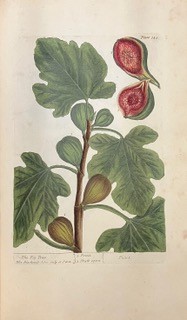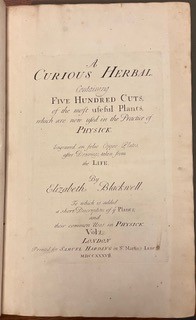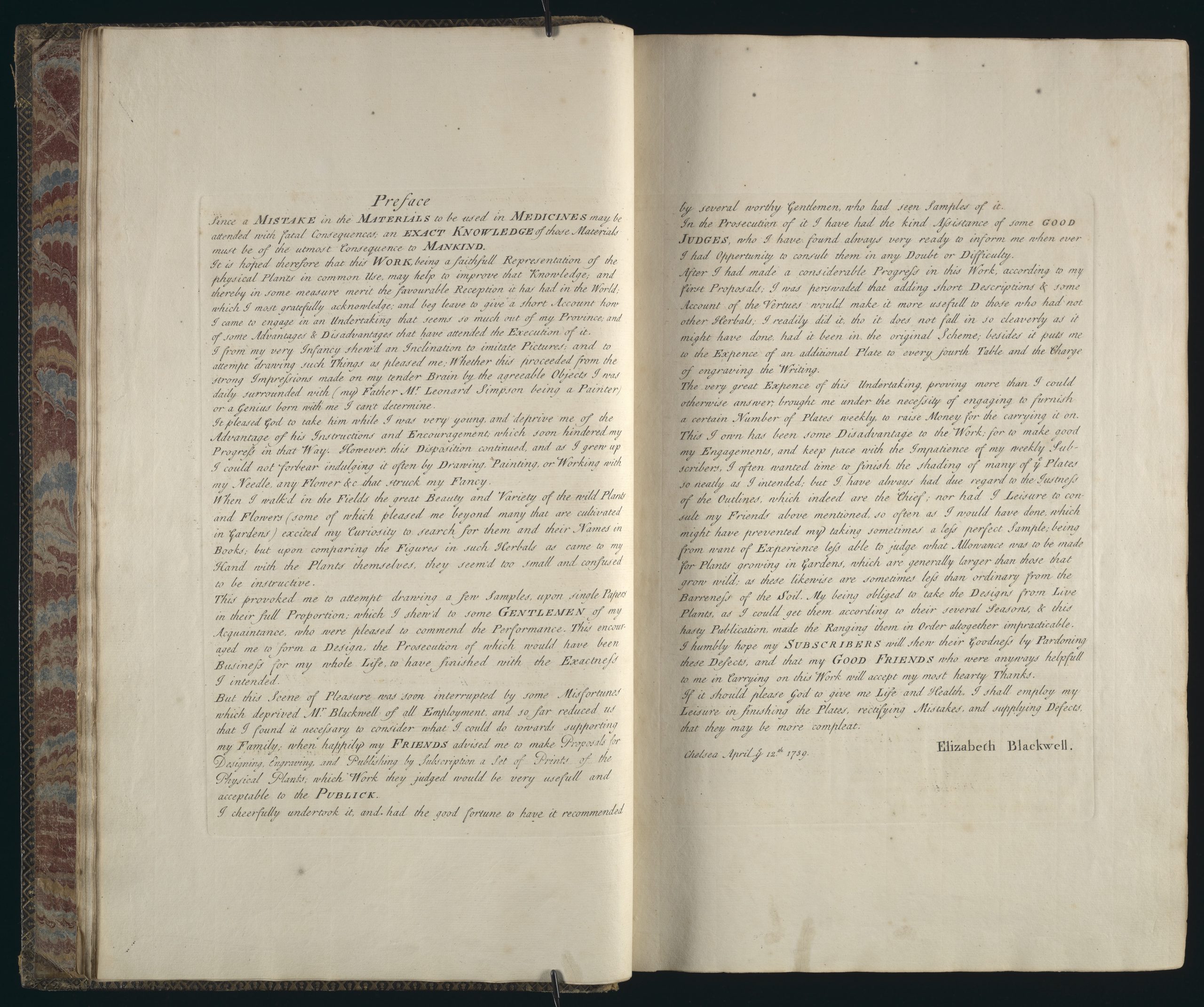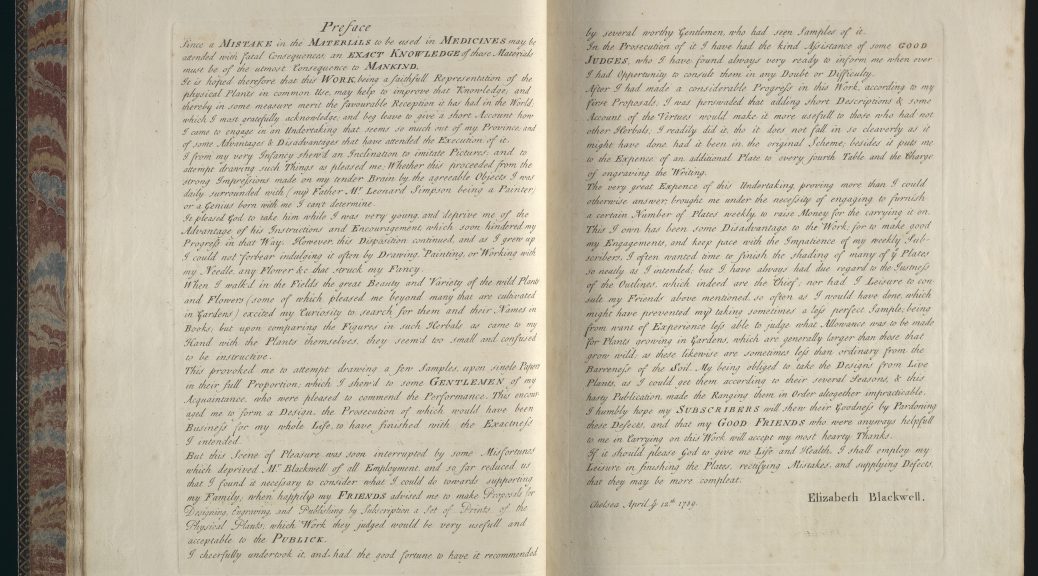Post contributed by Janet Stiles Tyson, independent researcher.

This blog post concerns a copy of a historically significant English herbal, held by the Rubenstein Library. Along with its producer Elizabeth Blackwell, A Curious Herbal[1] comprised the topic of my PhD thesis for Birkbeck College, University of London. It remains the focus of my post-doctoral research.
She was born in London in 1699 as Elizabeth Simpson, and married to a Scotsman named Alexander Blackwell. She made 500 life-size watercolor drawings of medicinal plants and translated those drawings on to etching plates, which were then sent to a printer to be produced as black-and-white multiples. After printing, Blackwell used watercolor paint to color many of the imprinted images. Between mid-1735 and mid-1739, those images were sold in fascicules or gatherings of four pages each. Each fascicule also included a page of text explaining the use of the four illustrated plants. Gatherings that contained four uncolored images cost one shilling; each group containing four colored images cost two shillings. Buyers compiled their pages (along with title pages, indexes, and other leaves that were printed and distributed) and had them bound—typically into two folio-format volumes.

Blackwell’s first publisher was Samuel Harding, whose name is found on title pages dated 1737. The name of Blackwell’s second publisher, John Nourse, is found on title pages dated 1739 and 1751. Copies also exist that were published under the name of Charles Nourse and dated 1782. However, composition and dating of extant copies isn’t as straightforward as this summary suggests, which is why much of my ongoing research involves finding and viewing as many copies as I can. Thus far, I have found about 110 copies, and have examined every single page of about sixty-five.
This brings me to the Rubenstein Library copy, which I visited in early August of this year [2022]. I first learned of it from catalogues for auctions held by Sotheby’s and Christie’s between 1981 and 2017. Online color photographs and verbal descriptions left me in no doubt about its beauty and importance. It was printed on extra-large folio sheets of paper, such that it measured about 18-by-12 inches in height and breadth. Pictures showed that its two volumes were bound in gold-stamped black morocco leather, and that the edges of its pages had been finished in gold. It also was evident that the plates had been colored with great care and subtly.
It originally had been owned by a London apothecary named Josiah Messer (1753-1830), whose signature was inscribed on the verso of the title page. A watercolor drawing and a hand-colored etching had been inserted at the back of volume one. Bookplates for another, presumably later, owner named George Hubbard were affixed to the marble endpapers in each volume. Assuming that its last sale at auction had been to a private collection, it seemed that I would never see Josiah Messer’s copy of A Curious Herbal.
Thus I watched, incredulously, as Rubenstein librarians removed the two volumes of the Messer copy from their archival boxes.

I began carefully turning its pages. Messer’s signature was on the reverse of the title page. There were the customary two pages of endorsements by various medical men. There were five lavishly etched and engraved dedicatory leaves that I knew from other copies. And there was a blank leaf where the first explanatory page should have been. Briefly perplexed, I decided that explanatory pages had been arranged to face the first image of each group of four. I’d seen that in other copies and would duly note.
I turned the page to find its verso filled with words from top to bottom, facing the front of another densely printed page. The word ‘Preface’ topped the first, and at the bottom of the second was the name ‘Elizabeth Blackwell’, and the legend: ‘Chelsea April ye 12th 1739’. After some preliminaries were the words:
I from my very Infancy shew’d an Inclination to imitate Pictures and
to attempt drawing such Things as pleased me; Whether this
proceeded from the strong impressions made on my tender Brain by
the agreeable Objects I was daily surrounded with (my Father Mr.
Leonard Simpson being a Painter) or a Genius born with me I can’t
determine.
A shiver of excitement shot from my head to my fingertips at ‘my Father Mr. Leonard Simpson being a Painter’. Hurriedly I told the librarians about this discovery, then returned to my table to email my Birkbeck supervisors, Vanessa Harding and Carmen Mangion. Both promptly messaged their kudos. Then, as I finished reading Blackwell’s preface and proceeded to examine and photograph further pages, Harding sent me another email.
Applying decades of research experience, Harding quickly found two other documents that cited Leonard Simpson by name. One announced the birth of a daughter to ‘Mr Leonard Simpson Designer in Paintings’, who lodged with a ‘Mr Simpson shoomaker of the Parish of St Mary Woolchurchhaw’. Dated ‘Aprill 1699’, it stated that daughter Elizabeth was born on the ‘three and twentith day of this moneth’ and ‘baptized the 4th of May following’. The second document further noted that shoomaker Simpson’s dwelling was ‘next door to the White Horse in Poultry’.

Over the years, I’ve found other Simpson references, including information that identified Blackwell’s mother’s name as Alice. But the Rubenstein copy holds the key to confirming Elizabeth Blackwell’s birth date and place. So much more could be said about this book and its illustrations, and the myriad curious tales of Elizabeth Blackwell. And perhaps further research will find further copies of that preface. For now, however, I hope that I have communicated the importance of this object at Duke University.
Works cited
Blackwell, Elizabeth (1737). A Curious Herbal. Containing Five Hundred Cuts of the most useful Plants, which are now used in the Practice of Physick. Engraved on folio Copper Plates, after Drawings, taken from the Life. By Elizabeth Blackwell. To which is added a short Description of ye Plants; and their common Uses in Physick. London: Printed for Samuel Harding in St Martin’s Lane, MDCCXXXVII (1737) Rubenstein QK99.A1 B53 1737 folio v.1 c.1.
London Metropolitan Archives. Parchment register of the parish of St Mary Woolnoth, 1686-1726: LMA, P69/MRY15/A002/MS07636.
London Metropolitan Archives. Paper register of the parish of St Mary Woolnoth, 1695-1706: LMA, P69/MRY15/A/002/MSo7636.
[1] Full title: A Curious Herbal. Containing Five Hundred Cuts of the most useful Plants, which are now used in the Practice of Physick. Engraved on folio Copper Plates, after Drawings, taken from the Life. By Elizabeth Blackwell. To which is added a short Description of ye Plants; and their common Uses in Physick.



One thought on “The Rubenstein Library’s disruptive copy of A Curious Herbal”
Comments are closed.